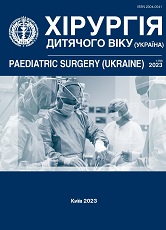Otoplasty with underdevelopment of the antihelix in children
DOI:
https://doi.org/10.15574/PS.2023.78.30Keywords:
otoplasty, protruding ear, underdevelopment of the antihelix, childrenAbstract
Purpose - to develop a method of otoplasty in children with underdevelopment of the antihelix.
Materials and methods. Otoplasty in our own way in case of underdevelopment of the antihelix was performed in 47 children (30 girls and 17 boys) aged from 6 to 16 years. All patients had bilateral deformity. The postoperative follow-up period was to 5 years.
Results. Otoplasty in children with underdevelopment of the antihelix was performed by our own method, which included detachment of the skin on the posterior and anterior surface of the auricle from the cartilage with an anesthetic solution, excision of the skin in the form of an ellipse on the posterior surface of the auricle, cutting the cartilage to the perichondrium along the outer edge of the antihelix, and making staggered notches on the entire thickness of the cartilage, forming the antihelix with U-shaped sutures. The result of the correction was the correction of proportional disorders, ensuring the symmetry of both ears. First of all, the excessive protrusion of the upper part of the auricle was eliminated, since some protrusion of the middle and lower parts may be acceptable. The full-face helix of both auricles was visualized through an antihelix. An even and smooth contour of the antihelix along its entire length was provided. The nuchal recess was not reduced too much, while its shape was not violated. Excessive pressing of the auricle against the head was avoided. Staggered notches help to reduce the excessive pressure on the suture, prevent tension of the ear cartilage and overcorrection during the formation of the antihelix.
Conclusions. The proposed method provides minimal trauma, promotes the formation of a natural antihelix shape and provides a good cosmetic result in children with protruding ear with underdeveloped antihelix.
The research was carried out in accordance with the principles of the Declaration of Helsinki. The study protocol was approved by the Local Ethical Committee of the institution mentioned in the work. Informed consent was obtained from the parents of the children (or their guardians), children.
No conflict of interests was declared by the authors.
References
Ali K, Meaike JD, Maricevich RS, Olshinka A. (2017, Aug). The Protruding Ear: Cosmetic and Reconstruction. Semin Plast Surg. 31 (3): 152-160. https://doi.org/10.1055/s-0037-1604241; PMid:28798550 PMCid:PMC5550315
La Trenta G. Otoplasty. (1994). In: Rees TD, LaTrenta GS, eds. Aesthetic Plastic Surgery. 2nd ed. Philadelphia, Pa.: Saunders: 891-921.
McDowell AJ. (1968). Goals in otoplasty for protruding ears. Plast Reconstr Surg. 41: 17-27. https://doi.org/10.1097/00006534-196801000-00004; PMid:5639206
Mogl AG, Palackic A, Cambiaso-Daniel J, Duggan RP, Vappiani M, Giraudi C, Raposio E, Bertossi D, Gualdi A. (2022, Jun 15). Conchal Excision Techniques in Otoplasty: A Literature Review. Plast Reconstr Surg Glob Open. 10 (6): e4381. https://doi.org/10.1097/GOX.0000000000004381; PMid:35720202 PMCid:PMC9200380
Nassimizadeh A, Nassimizadeh M, Grace LP. (2019). Auricular prominence and otoplasty - An overview. Journal of ent masterclass. 12 (1): 71-74. https://doi.org/10.1155/2019/9437641; PMid:30911426 PMCid:PMC6398039
Okumus A. (2020). Importance and necessity of surgical combinations in the correction of prominent ears for natural and long-lasting results. Turkish Journal of Plast Surg. 28 (1): 33-37.
Schneider AL, Sidle DM. (2018, Feb). Cosmetic Otoplasty. Facial Plast Surg Clin North Am. 26 (1): 19-29. https://doi.org/10.1016/j.fsc.2017.09.004; PMid:29153186
Downloads
Published
Issue
Section
License
Copyright (c) 2023 Paediatric Surgery (Ukraine)

This work is licensed under a Creative Commons Attribution-NonCommercial 4.0 International License.
The policy of the Journal “PAEDIATRIC SURGERY. UKRAINE” is compatible with the vast majority of funders' of open access and self-archiving policies. The journal provides immediate open access route being convinced that everyone – not only scientists - can benefit from research results, and publishes articles exclusively under open access distribution, with a Creative Commons Attribution-Noncommercial 4.0 international license(СС BY-NC).
Authors transfer the copyright to the Journal “PAEDIATRIC SURGERY.UKRAINE” when the manuscript is accepted for publication. Authors declare that this manuscript has not been published nor is under simultaneous consideration for publication elsewhere. After publication, the articles become freely available on-line to the public.
Readers have the right to use, distribute, and reproduce articles in any medium, provided the articles and the journal are properly cited.
The use of published materials for commercial purposes is strongly prohibited.

